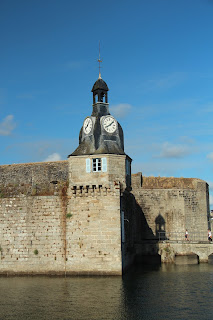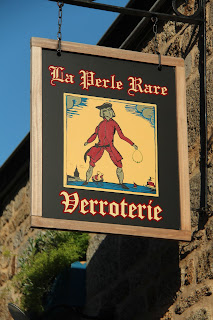 |
| Cairn de Barnenez |
We put up our tent at Camping Les Blancs Sablons, a nice place very close to a beautiful beach and in walking distance of Le Conquet, which was important for us as we planned to visit Ouessant island and wanted to get to the port without using the car. On our first evening in Le Conquet, we followed a recommendation we found in our guidebook and had dinner at the wonderful Le Relais du Vieux Port. Even Commissaire Dupin visits the "Relais" for a late dinner in Jean-Luc Bannalec's latest book (not yet available in English).
 |
| Les Blancs Sablons |
 |
| Le Conquet |
On the next day we took the early ferry over to Ouessant. Unfortunately, the weather was quite misty and cloudy, but we still enjoyed a walk across the island to the lighthouse called Créac'h which is 150 years old. Lighthouses have a special importance in Brittany, as the coasts are cragged and there are many dangerous spots for ships. At Créac'h, there's an impressive museum about lighthouses in Brittany, well worth a visit!
 |
| Créac'h |
Back in Le Conquet we needed something for dinner and ended up in a small restaurant (I don't know the name anymore) - but their menu was quite diverse, so I could order pizza and Monsieur something french. He loves seafood which I absolutely can't stand, so our holidays at the sea always have to include at least one visit of a good seafood place - but on that memorable evening, he ordered Andouillettes, actually without really knowing what it is. He asked the waitress about it but she couldn't explain it in English and we didn't really understand what she described in French, something with a pig's belly... Well, that was good enough for Monsieur to order it. The Andouillettes came, and they looked like huge sausages and smelled... like poo. Wikipedia says "True andouillette is rarely seen outside France and has a strong, distinctive odour related to its intestinal origins and components." - spot on. Later Monsieur said he should've known it because he suddenly remembered having ordered Andouillettes a few years ago in Bordeaux and not being able to eat it because of the smell. I guess he won't try it again.
We both really like lighthouses, and in Brittany there's so many of them you surely can't claim you haven't seen enough of them during your stay. One of the most beautiful lighthouses we visited is St. Mathieu, a very special place because the lighthouse is neighboured by the ruins of an old monastery.
Menhirs (from Breton "men" - "stone" and "hir" - "long") are quite common for Brittany. The Kerloas menhir is the tallest standing stone in France and was the first menhir we visited. It's an impressive sight, about 10m tall and standing on top of a hill, a fascinating landmark.
Our next camping site was Trez Rouz on Crozon peninsula. Another really nice place close to a beautiful beach and only a short drive away from interesting sights like the grottes de Morgat and the starting points for cool hikes like the one we did from Pen Hir. The evenings on the beach were glorious, those views are one of the things I love best about Brittany.
The hike starting from Pointe de Pen Hir was wonderful. The cliffs right at the Pointe are breathtaking, and during the hike we saw more of them - and a white beach where swimming was forbidden, which didn't stop the surfers at all.
Another great place we visited are the grottes de Morgat, the caves of Morgat. We boarded one of the tourists' boats and enjoyed a tour of about 45 minutes. The captain did not only tell us a lot about the caves, but also about geographical, geological and marine characteristics of the region and he showed us seabirds on the cliffs. Very interesting!
In the evening, we visited Camaret sur mer. We ate at a seafood place right at the port and afterwards took a walk to the famous chapel Notre Dame de Rocamadour. It's a really special place, as it becomes very clear to the visitors that people in Brittany live (and have always lived) with the dangers of the sea. Inside the church there is a lot of marine-themed decoration, and there is a procession in memory of all sailors who died at sea each year.
 |
| Notre Dame de Rocamadour |
On our way southwards the next day, we visited Quimper for lunch, and, in the afternoon, we also stopped in Pont-Aven.
 |
| Quimper |
Pont-Aven is often called "the village of artists", because in the end of the 19th century, some artists - among them Paul Gaugin - have stayed there and founded the Pont-Aven School. Today, there's many art galleries and even more tourists, but there's still a few places in the village where the old times seem to be not so far gone.
 |
| Paul Gaugin - Paysage de Bretagne. Le moulin David. |
Every day we came closer to the last leg of our trip, the south of Brittany, the Morbihan region. We were looking forward to kayaking on the Gulf of Morbihan, seeing more menhirs, and visiting the Guérande, where salt is the most important thing.



















































